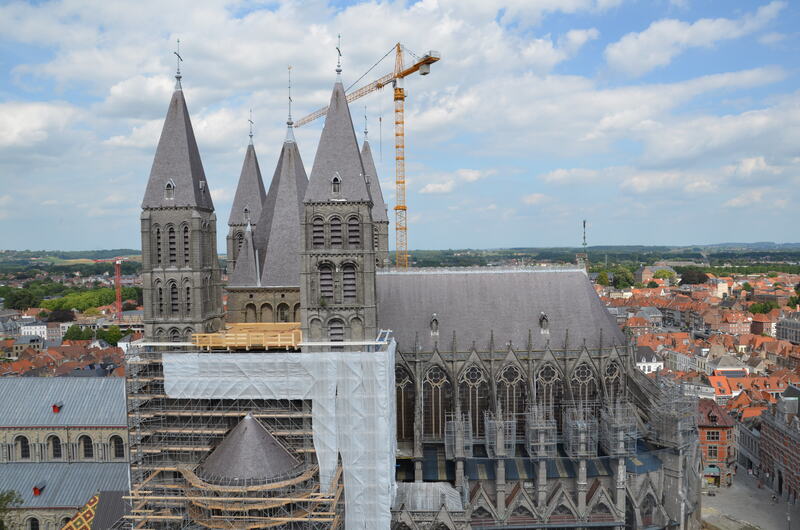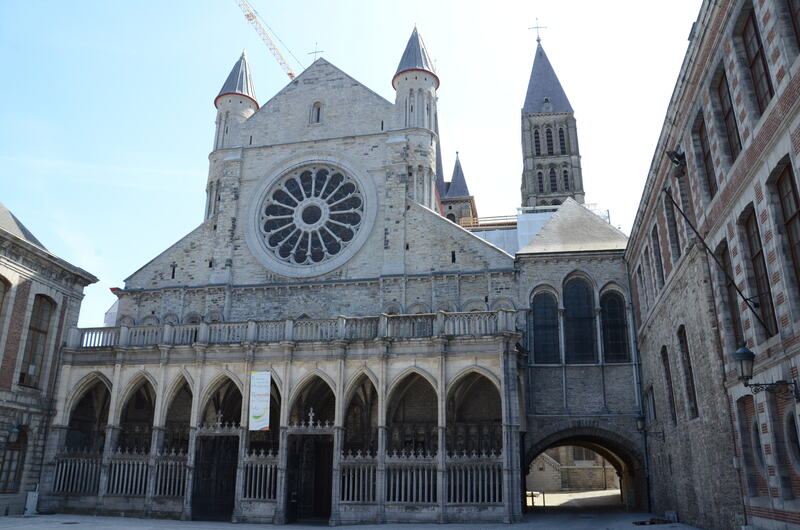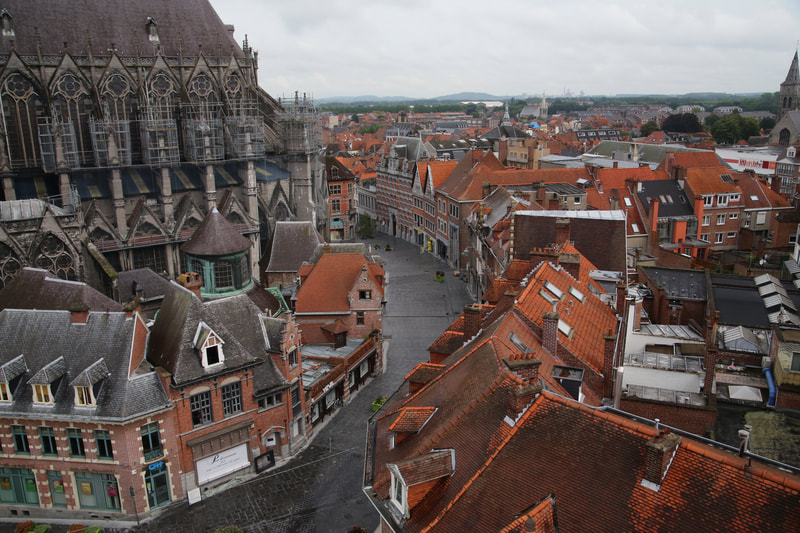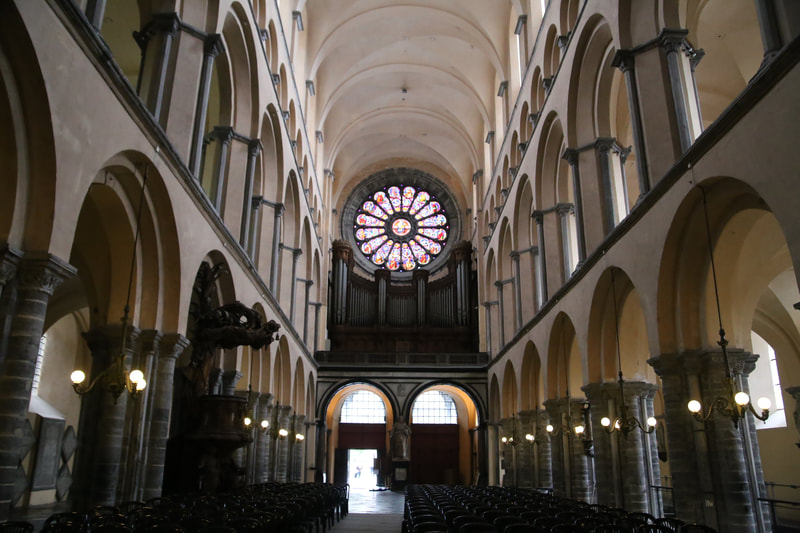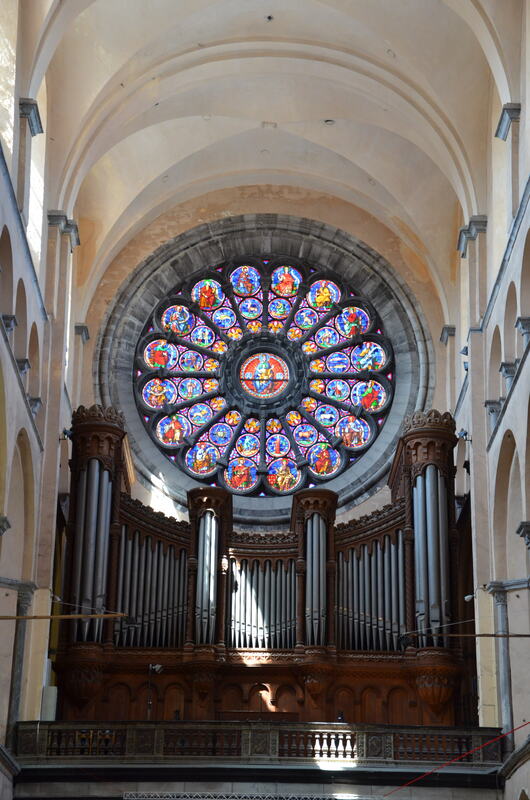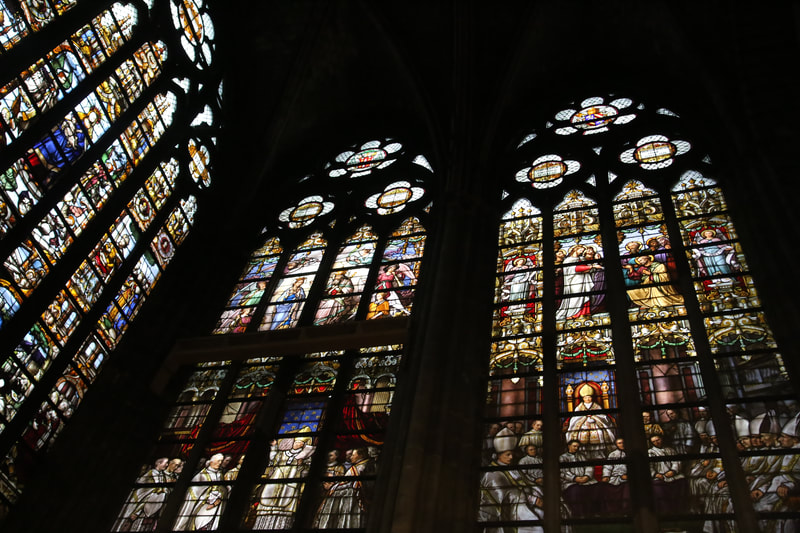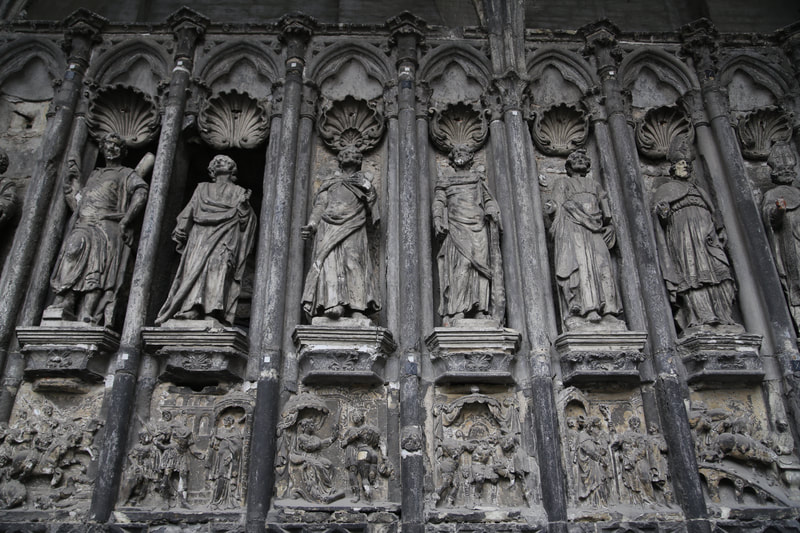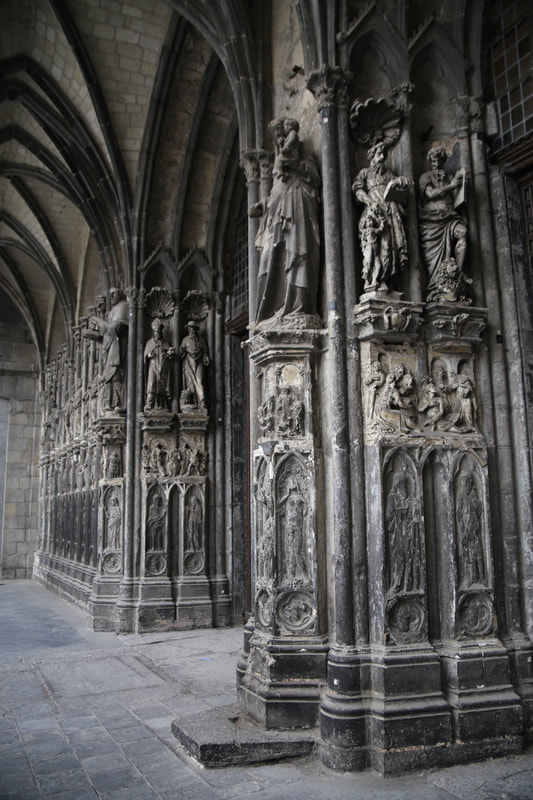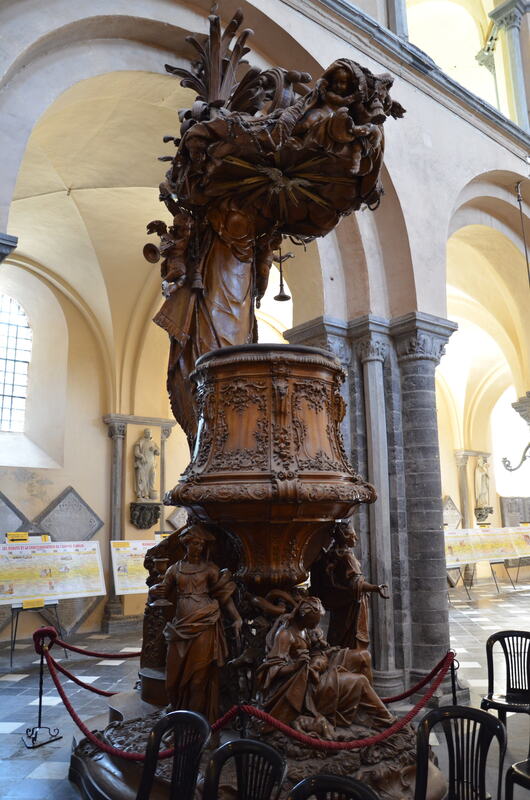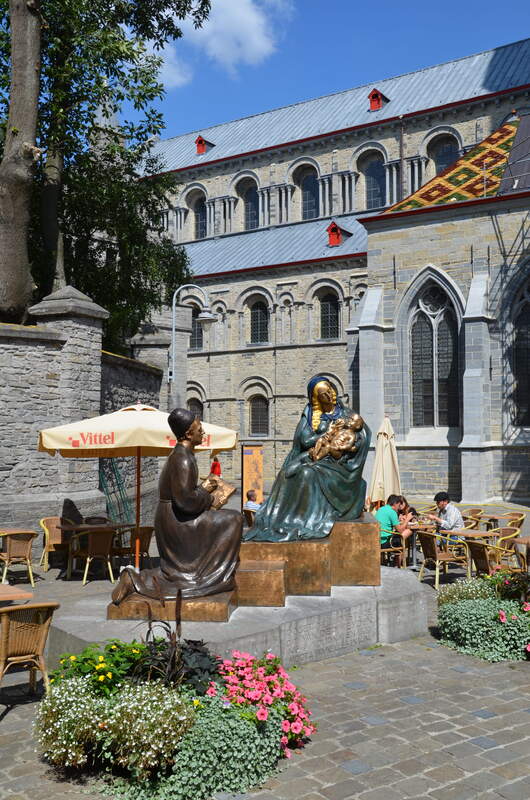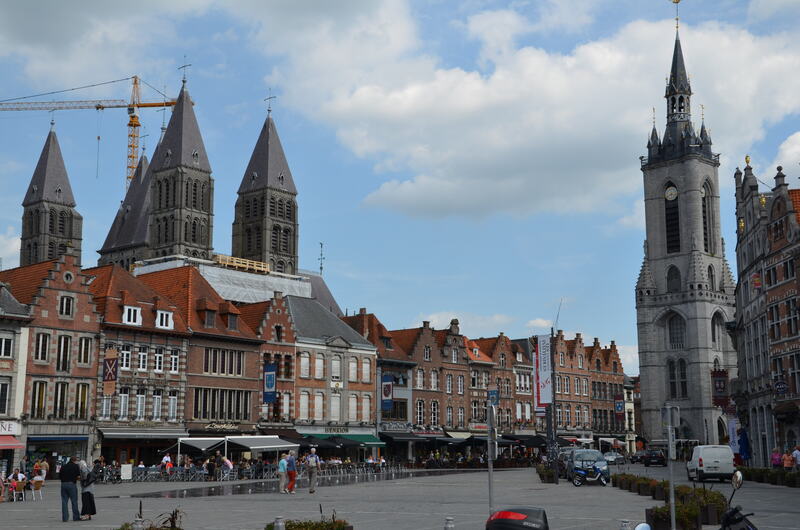Cathedral of Our Lady |
vertical divider
Majestatyczna budowla, będąca symbolem Tournai. Jej niespotykane kształty, na czele z pięcioma wieżami, subtelne i harmonijne połączenie stylu romańskiego, widocznego w nawie i transepcie katedry, ze stylem gotyckim, w chórze, są przykładem mistrzostwa artystów epok minionych i powodem wpisania Katedry w 2000 roku na Listę Światowego Dziedzictwa UNESCO.
|
Wcześniej, bo już w 1936 roku, sklasyfikowano Katedrę z Tournai jako dziedzictwo historyczne francuskojęzycznej części Belgii. Uważa się, że rozpoczęcie budowy romańskich elementów katedry nastąpiło w pierwszej połowie XII wieku. Podczas prac archeologicznych, prowadzonych w świątyni, odkopano między innymi grobowce dwóch biskupów Tournai Baldwina I i Radboda II. Badania wykazały, że w miejscu, w którym stoi katedra w przeszłości istniały inne kościoły. Pierwszy wybudowano z rozkazu ówczesnego władcy Tournai Chlodwiga I, z rodu Merowingów.
The dimensions of the temple
|
Długość katedry: 134 metry
Długość transeptu: 67 metrów Długość prezbiterium: 58 metrów |
Wysokość prezbiterium: 33 metry
Długość nawy: 48 metrów Wysokość wież: 83 metry |
Budowę romańskiej, dziewięcioprzęsłowej nawy głównej rozpoczęto około 1100 roku. Jej regularny czteropoziomowy kształt, przypominający akwedukt, wywołuje wrażenie oglądania budowli z antycznego Rzymu. Ponad wejściem znajduje się piękna neoromańska rozeta, o średnicy siedmiu metrów, górująca nad wielkimi organami. Fasadę zachodnią stanowi ostrołukowa kruchta z podwójnym portalem. Jej niższe partie zdobią rzeźby z XIV-XVII wieku. Przedstawiają one postaci świętych, epizody z historii miasta, oraz sceny ze Starego Testamentu. The temple has five towers. Four of them are seven storeys high and rise to a height of 83 meters. The fifth tower, located above the rectangular crossing of the naves, has six floors. The transept and the nave were consecrated in 1171.
Interior of the Church of the Blessed Virgin Mary
W czasie szalejącej w Niderlandach rewolty ikonoklastów zniszczono wiele rzeźb i cennych dokumentów. W roku 1794 oddziały francuskich rewolucjonistów dokonały kolejnych zniszczeń w katedrze. W latach 1850-1860 przeprowadzono renowację świątyni. Następne prace konserwatorskie miały miejsce po II Wojnie Światowej. Obecnie w katedrze trwają prace na ogromną skalę. Od kilku lat wzmacnia się fundamenty wież, które ucierpiały w wyniku tornada, jakie przeszło nad miastem w 1999 roku.
Jednym z największych skarbów katedry jest wspaniałe renesansowe lektorium, które stworzył, w latach 1570-1573, rzeźbiarz pochodzący z Antwerpii Corneille Floris. W gotyckiej kaplicy św. Ludwika znajdują się dwa sławne obrazy: Rubensa Uwolnienie dusz z czyśćca, z 1634 roku, oraz Ukrzyżowanie, namalowane przez Joardensa. Z zewnątrz dach kaplicy pokryty jest pięknymi kolorowymi panelami, z 1729 roku. Kaplica św. Wincentego, stanowiąca połączenie Pałacu Biskupów z nawą katedry, jest wspaniałym przykładem początków gotyku w dolinie Skaldy. Konsekrowano ją w 1198 roku.
Jednym z największych skarbów katedry jest wspaniałe renesansowe lektorium, które stworzył, w latach 1570-1573, rzeźbiarz pochodzący z Antwerpii Corneille Floris. W gotyckiej kaplicy św. Ludwika znajdują się dwa sławne obrazy: Rubensa Uwolnienie dusz z czyśćca, z 1634 roku, oraz Ukrzyżowanie, namalowane przez Joardensa. Z zewnątrz dach kaplicy pokryty jest pięknymi kolorowymi panelami, z 1729 roku. Kaplica św. Wincentego, stanowiąca połączenie Pałacu Biskupów z nawą katedry, jest wspaniałym przykładem początków gotyku w dolinie Skaldy. Konsekrowano ją w 1198 roku.
The treasury of the temple
Wśród najcenniejszych eksponatów są dwa wyjątkowe relikwiarze. Pierwszy to romańsko-gotycki châsse de Notre-Dame, z 1205 roku, wykonany przez Nicolasa de Verduna z posrebrzanej i pozłacanej miedzi, ozdobiony rzeźbami postaci ubranych w pofałdowane togi i medalionami przedstawiającymi sceny z życia Chrystusa.
Drugim relikwiarzem jest châsse de Saint-Eleuthère z 1247 roku. Te dwa wspaniałe przykłady średniowiecznej sztuki złotniczej zostały wpisane w 2011 roku na listę Kulturalnego Dziedzictwa Federacji Walońsko-Brukselskiej. W skarbcu znajdują się ponadto wspaniałe liturgiczne szaty sprzed stuleci, kolekcja złotych przedmiotów oraz arrasy.
W lutym 2008 roku grupa uzbrojonych mężczyzn wtargnęła do skarbca, terroryzując bronią pracowników i zwiedzających. Skradziono bezcenny bizantyjski Krzyż z X wieku, będący w Katedrze w Tournai od XIII wieku, a także wiele drogocennych skarbów.
Drugim relikwiarzem jest châsse de Saint-Eleuthère z 1247 roku. Te dwa wspaniałe przykłady średniowiecznej sztuki złotniczej zostały wpisane w 2011 roku na listę Kulturalnego Dziedzictwa Federacji Walońsko-Brukselskiej. W skarbcu znajdują się ponadto wspaniałe liturgiczne szaty sprzed stuleci, kolekcja złotych przedmiotów oraz arrasy.
W lutym 2008 roku grupa uzbrojonych mężczyzn wtargnęła do skarbca, terroryzując bronią pracowników i zwiedzających. Skradziono bezcenny bizantyjski Krzyż z X wieku, będący w Katedrze w Tournai od XIII wieku, a także wiele drogocennych skarbów.
|
Katedra
1 kwietnia-31 Octoberdziernika poniedziałek-piątek 9.00-18.00 sobota, niedziela, święta 9.00-12.00 i 13.00-18.00 1 listopada-31 marca poniedziałek-piątek: 9.00-17.00 sobota, niedziela: 9.00-12.00 i 13.00-17.00 Zarówno Katedra, jak i skarbiec nie są dostępne dla zwiedzających w czasie mszy świętej od poniedziałku do piątku: 11.00-12.00, oraz w sobotę i niedzielę: 10.00-11.00 Wstęp do katedry jest darmowy. |
Skarbiec
1 kwietnia-31 Octoberdziernika poniedziałek: 13.00-18.00 wtorek-piątek: 10.00-18.00 sobota, niedziela, święta: 13.00-18.00 1 listopada-31 marca poniedziałek-piątek: 9.00-12.00 i 14.00-17.00 sobota, niedziela, święta: 14.00-17.00 Należy pamiętać, że kasa biletowa jest zamykana na pół godziny przed zamknięciem skarbca. Koszt biletu do skarbca-2,5 Euro. |
